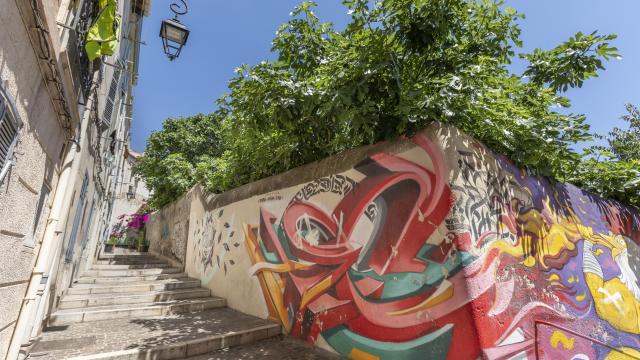Cultural sites in the heart of the old town
The old town of Marseille is very colourful with narrow streets full of character, and the cultural sites make it even more breathtaking!
The ‘Maison Diamantée’ (Diamond House)
Constructed by rich Spanish and Italian traders, the Maison Diamantée was occupied by prominent families from Marseille. The house is magnificent with its facade of pointed diamond-shaped stones and a paneled staircases. It was classified as a historical building in 1925 and spared from being demolished in 1943.
The Daviel Pavillon
It was built in the middle of the 18th century by the Gérard brothers – architects from Marseille – on the site where an old Court House was previously standing. During the French revolution, a guillotine was standing on the square. The monument is built with pink stones excavated from the Couronne’s quarry. Today, it hosts the city Townhall.
The Cabre Hotel
The construction of this private mansion in 1535 was ordered by Louis Cabre, a consul and merchant. It is one of the oldest houses of Marseille. It was spared from being demolished when the old suburbs were destroyed in 1943. But because of urban reconstruction, it was moved from its original location with the use of hydraulic cylinders and rotated by 90° to be aligned with the actual streets. The monument facades are classified as historical buildings since 1941.
The ‘Hôtel Dieu’
The ‘Hôpital Saint-Esprit’ (the Holy Spirit Hospital) was built in the 12th century. It has been extended over the years and merged with the hospital ‘Saint-Jacques de Galice’ in the 16th century. It became ‘Hotel Dieu’ a century later. It was then rebuilt by the nephew of the famous architect Hardouin-Mansart, who only partially completed his ambitious project. It was only during the second Empire that the ‘Hotel Dieu’ became the building it is today. The staircases are the work of Joseph-Esprit Brun. The bronze bust representing Jacques Daviel is meant to remind us of the first cataract-removal surgery that he performed in 1745 in the Hotel Dieu. He was then appointed as king Louis VI’s oculist. In 2013, the establishment became a 5-star hotel.
The church of ‘Accoules’
The small parochial church dedicated to ‘Notre-Dame des Accoules’ has been standing there since the 11th century. The church was rebuilt in the 13th century with the bell tower of the Sauveterre, from where the alarm bell was rung to summon the town council. The whole area was partially razed in 1794 and the church was rebuilt with a centered floor plan just before the July Monarchy.
The ‘Place de Lenche’ (Lenche square)
The ‘Place de Lenche’ is located on the old greek agora from where citizens could watch over the port’s activities. Originally, the square was closed on all four sides. In the 5th century, Saint-Cassien founded the nun’s convent of ‘Saint-Sauveur’ (Saint-Saviour) on the South side of the square, facing the ‘Saint-Victor’ monastery on the other bank.
Underneath the square, the vaults of ‘Saint-Sauveur’ are thought to have been the greek city’s water tanks in the 3rd century B.C. They were classified as Historical Monuments in 1840 and they are considered an undamaged relic but remain inaccessible. The name ‘Lenche’ comes from a Corsican family called Lincio who became renowned in the city for setting up a coral workshop, shops, and for building a sumptuous townhouse.
The southern part of the square has been destroyed following german authorities’ plans in the winter of 1943.Buildings were rebuilt in the 1950s below the square.
The ‘Place des Moulins’ (Mills square)
This square is the highest point of this out-of-the-ordinary suburb and owns its name to the fifteen windmills which were located there in the 17th century.
Today, the remnants of three of them are incorporated in houses and unfortunately cannot be accessed. In 1850, the windmill water tank was built under the square, 35 meters under sea level.
The tank includes 160 pillars made with stones from Cassis and has a capacity of 12,000 cubic meters. The architecture is reminiscent of the Balisica Cistern in Istanbul.





















